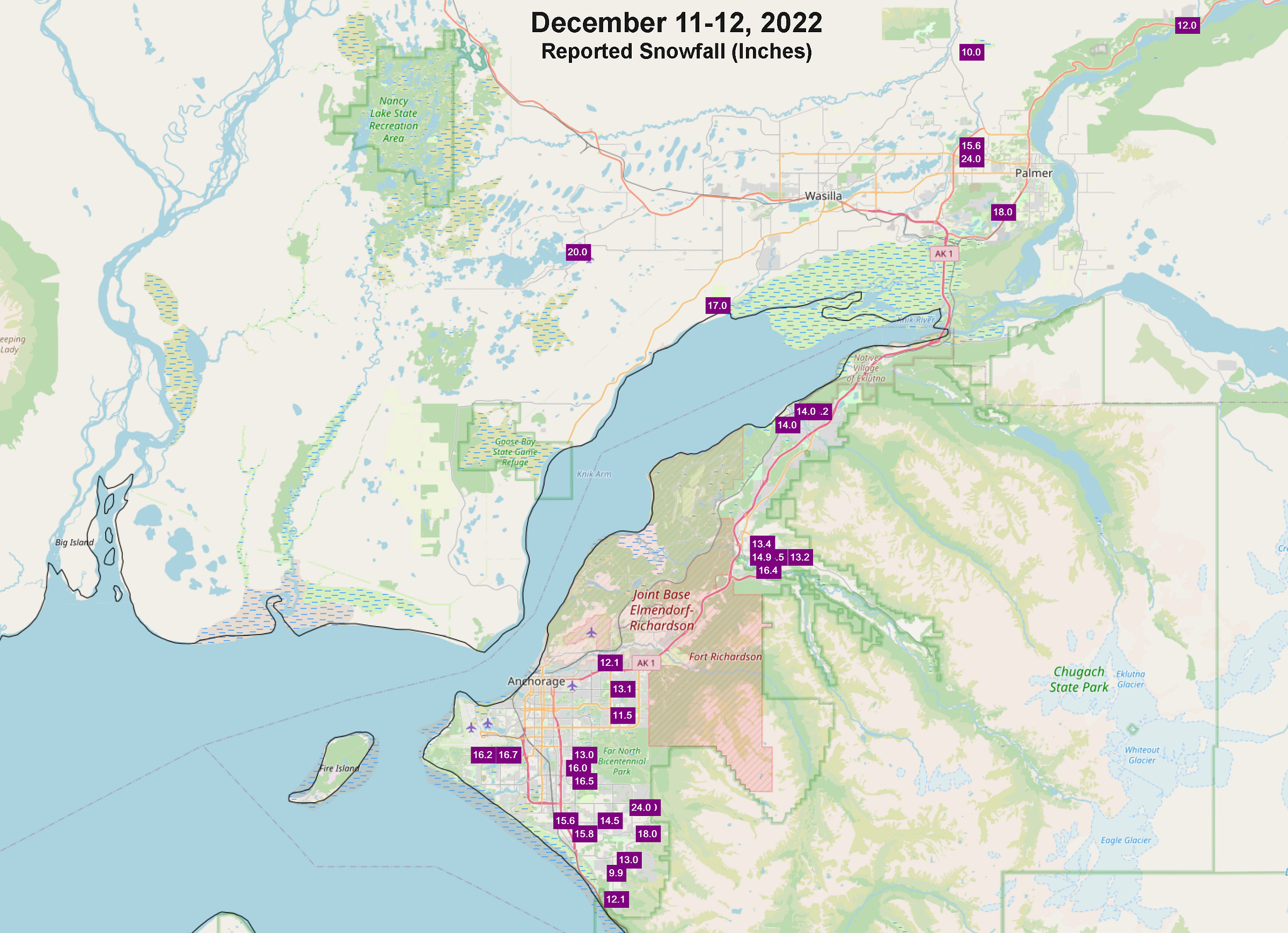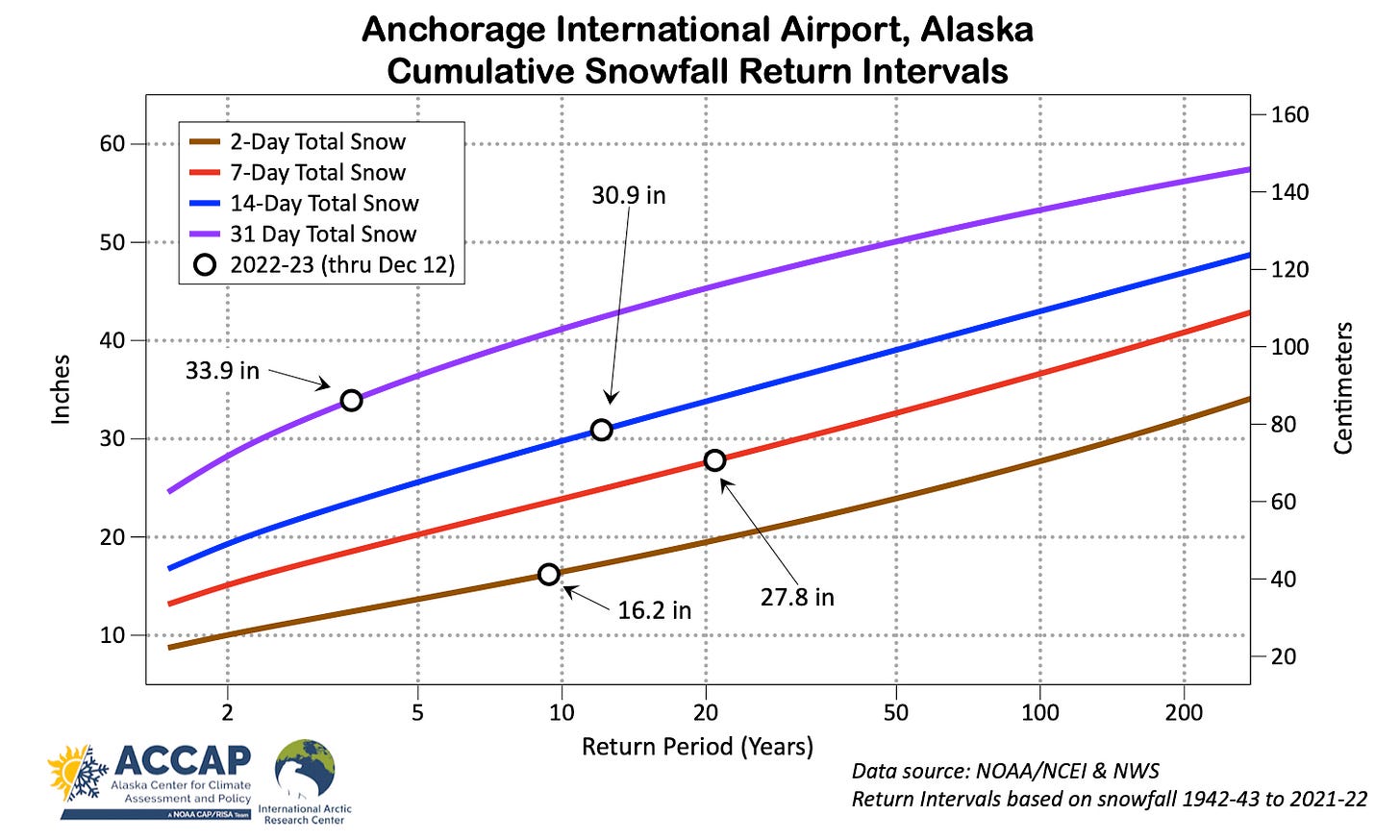December 16: An update to this post (Decemeber 16, 2022) is here.
Anchorage, and indeed much of Southcentral was inundated with several rounds of snow between December 5th and 12th, including major storms December 6th to 7th and another storm December 11-12. The December 6-7th storm feature a dramatic spread in snowfall amounts across urban Anchorage, with west Anchorage receiving 11 to 15 inches while some areas on the east side of town (at low elevation) received 20 to 25 inches. The second storm saw less spread in snowfall amounts in Anchorage proper but much higher amounts than the first storm in the Palmer and Wasilla areas. Storm total reports from the NWS Anchorage Forecast Office. Fig 1. shows the NWS reported amounts for the first storm and Fig 2. for the December 11-12 storm (large format needed to make the reported amounts readable).


For the first 12 days of December, the NWS Office near the Anchorage Airport has reported nearly 30 inches (75 cm) of snow, including a 7-day total of 27.8 inches (70.6cm) between December 6 and December 12. Other places in the urban area have already exceeded 40 inches (102 cm) for the month. While there has not been any rain, the snow has not been especially powdery. The Anchorage Airport has already set the December monthly precipitation record with 2.68 inches (68.1 mm, all melted snow), eclipsing the previous record of 2.67 inches (67.8 mm) set in 1955 and tied in 2011. And there’s still 19 days remaining to add to the total.
So how do these recent snow storms rank historically? With Anchorage International Airport being the only active long-term climate site in the Anchorage urban area which we can use for comparative purposes, the 16.2 inches (41.1 cm) December 11-12th looks to rank as the tenth highest two-day total in the past 70 years. The five largest two-day snow totals are:
December 28-29, 1955: 29.0 inches (73.7 cm)
March 16-17, 2002: 26.7 inches (67.8 cm)
Febuary 10-11, 1996: 22.4 inches (56.9 cm)
November 19-20, 1964: 20.0 inches (50.8 cm)
March 17-18, 1976: 18.7 inches (47.5 cm)
However, the especially remarkable feature of early December 2022 was the occurrence of two big storms inside of a week, and here we find that 2022 comes in at number five:
The five largest seven-day snow totals are:
February 5-11, 1996: 37.8 inches (96.0 cm)
December 25-3, 1955: 35.7 inches (90.7cm)
February 28-March 8, 1959: 29.9 inches (75.9cm)
December 17-23, 2003: 28.5 inches (72.4 cm)
December 11-12, 2022: 27.8 inches (70.6 cm)
We can quantify the relative extreme nature of the snowfall by asking how frequently we might expect to see this much snow. That’s plotted in Fig. 3. below. Here I’ve used the Weather Bureau/National Weather Service observations from Merrill Field and Anchorage International from 1942-43 to last winter to generate 80 winters of maximum cumulative snowfall for four different time periods: 2-day, 7-day, 14-day and 31-day and then calculate return intervals specific amounts of snow for those time periods. For easy interpretation I’ve plotted where 2022-23 stands as of December 12. From this perspective, you can see that the 7-day snowfall fairly unusual: getting 28 inches or more of snow in a week at Anchorage Airport can be expected to occur, on average, only once in 20 years. Another, possibly preferable way to think of that is that there is about a five percent chance in any given winter of getting that much snow in a week. That certainly makes this week notable, but it’s a long way from “never though it could snow so much.” On the other hand, as you might expect given its “mere” tenth place ranking, a two-day total of 16 inches is about a once in a decade occurrence.





Is the heavy snow in Anchorage something like the lake effect snow in Buffalo and other places? Does wind blow along the sound picking up extra water?